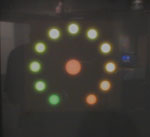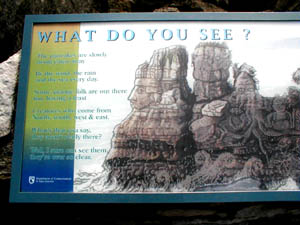
Disagreeing about color.
The Exploratorium was founded as a museum of science, art, and human perception.
We start our workshop with perception.
Observation is an important part of science and yet it is seldom taught in science courses. Many examples of poor science arise because people honestly report what they see, and yet their reports are flawed because they do not understand how their visual system can be fooled. Understanding perception is necessary to help us understand how there can be so many incorrect pseudoscientific reports in the media.
We'll visit three exhibits on the floor of the museum:
Then we'll take a break and return to the classroom to do four explorations.
After all of these explorations we'll return to discuss
What is Science? A science teacher's personal view
Three Museum Exhibits on Perception
I begin by taking participants to the Disagreeing about color exhibit.

Have you ever wondered whether two people can look at the same color and see different things?
Here is a simple exhibit that allows you to answer that question.
It is also an exhibit that opened my eyes to the idea that a student might look at the exact same thing that I am looking at and see something different!
This is an important lesson for a teacher.
Exhibit 2 Gray Step, You can't trust what you see.
This exhibit requires a printed gray step that is
beyond the capability of computer monitors and most printers. If you
wish to do this activity you will need to send me an e-mail and I
will send you an Exploratorium gray step postcard.
Do the Gray Step Snack first before you read on.
![]()
Here is a brief taste of what I do at the Gray Step Exhibit
I begin my lesson on illusions at the classic Exploratorium exhibit, Gray Step. (photo)
I ask the group of 15 teachers "What do you see?"
The bravest one ventures, "I see a rectangle of uniform gray with a fiber bundle covering its center line." Some of the others nod assent.
I respond, "you look like an honest person," and raise the fiber bundle.
There is a small group gasp.
I ask again "What do you see?"
This time one responds more hesitantly," I see two squares each with a different yet uniform shade of gray."
I respond, "you look like an honest person."
They look at me questioningly, surely, what they are seeing now is correct.
But it isn't.
I lay a viewer, which is a white plastic sheet with two holes in it spaced apart exactly one half the width of the gray step panel, over the exhibit. The viewer allows them to see that the two squares that look so different are actually identical. Each grades from the same shade of light gray on the left side to the same shade of dark gray on the right. Even once they have been shown this gradient with the viewer, they cannot see it when the viewer is removed.
Once a teacher pulled out a photographic spotmeter which measures the light reflected from objects to allow for correct photographic exposures. When he did this he was following an admonition of Robert Heinlein who said,"If it isn't quantitative, it isn't science, it's opinion." The spot meter confirmed that the two squares were identical gray gradients. Our eyes are not cameras.
Science
Mulch:
Each eye has over 100 million rods and cones which convert light into
electrical impulses. Each eye is connected to the brain by an "optic
nerve" which contains about one million neurons. In some sense then,
the optic nerve carries only one percent of the retinal image to the
brain.
An
aside:
It has been said that if you bought a camera that produced an image
as full of flaws as that produced by the human eye you would return
it immediately.
In reply it can be said that no one has ever been able to make a
camera from Jello.
Exhibit 3 Find the highest note, an audio illusion,
you can't trust your ears either.
The third exhibit is one that allows us to investigate hearing.

This exhibit presents an acoustic illusion. It shows that to study the world we have to understand perception for all of our senses.
The instructions seem easy enough, Find the
highest note.
I begin by playing the notes one after the other clockwise around the
circular keyboard.
After I go around twice people begin to smile. They realize that they are hearing an acoustical illusion.
I ask "What do you hear?" a variation on my usual question.
Someone answers,"the pitch of each note seems higher than the previous one. The pitch seems to go up and up as you go around the keyboard."
I then say,
"I have a simple question for you."
This is a warning that the question I am about to ask has no simple
correct answer.
"Let's look at just two keys."
I then say I am going to play a white key and a black key, and ask which has the higher pitch.
I play two keys that are next to each other on the keyboard with the white key clockwise from the black key. Everyone hears that the white key is higher in pitch than the black key. The order the keys are played doesn't mater, white followed by black or vice-versa.
Then I choose a black key and a white key on opposite sides of the circle, i.e. on opposite ends of a diameter. I play a white key first and then a black key. Many people say that the white key is higher in pitch, many say the black key is higher, a few say they cannot tell which is higher. Then I reverse the order playing the black key first and then the white key, a few people change their answers. The people look at each other realizing that even though they heard the same sounds, their perceptions of the sounds were different.
This is an important lesson for them to learn as they approach science.
People's perceptions of the same phenomena may be different. To study
a natural phenomena, scientists must perform experiments which get
around these human perceptual differences. Scientists must take into
account the human perceptual system when they evaluate "eyewitness
testimony" to natural events.
As we study science in this course the answer to many questions will involve differences in perception. I'll point out these perceptions as they occur. Also keep your eyes open for reports in the newspapers of UFO sightings. Very often these sightings are natural events. Observers often truthfully report what they perceive. To understand the natural event you must understand how the human perceptual system works.
Honesty is very important in science. As we go from exhibit to exhibit I'll ask "What do you see?" I need an honest answer from each class member. Even if your answer is different from everyone else's answer, even if the answer you give does not seem like the one that I, the teacher, want. This is a science class and honesty is most important. Through your different perception we might all learn something new.
Now it's time to take a break, relax, eat and drink and then return to the classroom refreshed and ready to explore some more.
The important idea behind these exhibit explorations is that two different people might have different perceptions of the same event. Keep this in mind when you hear people describe what they have seen or heard.
These are explorations of perception easily completed with simple materials in a classroom.
Exploration 1, Laser Speckle, the importance of honesty in science
After convincing you that you cannot trust your eyes, then it is time to convince you that honesty is an important underpinning of science.
You'll need to get a group of at least 8 people together for the next activity.
At the Laser Speckle Exhibit I tell people to look at the speckles and move their heads side-to-side. Then I ask:
What do you see?
Many Teachers report that they see dots, some see bright dots others see dark ones, some see the dots move.
I take a vote: How many people see the dots move opposite to the way they move their heads, often 9 out of 16 people make this choice. How many people see them move the same way? 4 people respond that they do. How many people see something else? The others raise their hands.
At this point everyone looks at each other as if
to say,
"What do you mean you don't see what I see?"
Others want to know,
"What is the right answer?"
In this activity there is no one right
answer.
Each person sees what they see!
The most important thing is to honestly report what you see.
This sets an important theme for the rest of the summer institute.
Say what you see even if everyone else in the class says that they see something else.
Honesty is the most important trait of a scientist.
There are many more things to learn at the laser speckle exhibit follow the link above toward further explorations.
Let's begin by having you find out if you have a dominant eye, and if you do which eye that is.

Once again with this activity we see that different people see different things. We find a whole spectrum of differences. We also look for dominant eyes by two different methods, one coarse method involves pointing at distant objects, another more refined method uses two mirrors and gives a better idea of just how dominant an eye is.
And now for an old classic

There is an entire book titled "The Moon Illusion," in which many experts argue over the explanation. In the end they do not reach a concessus. However, recently scientists have reached consensus on what produces this illusion.
Our final exploration is of an illusion involving craters.

Even chickens see the crater illusion!
Now is the time when you have to shout,"How do you know that?"
Chickens can be trained to peck at bumps or into
dimples in order to get food.
Show a chicken a photo of a bump or dimple like the ones in the
crater illusion and you can tell if the chicken sees it as a bump or
dimple!
Take a look at this reading which contains a few thoughts which help me &emdash; a science teacher &emdash; to interpret science as reported in the media and also to deal with student questions.
What is Science? One science teacher's view of science.
Tomorrow bring your thoughts and questions to
class, i.e. send them to pauld@exploratorium.edu.
We'll begin our study of light by examining the eye.
Return to the Summer Institute

This is my favorite question at the Exploratorium. After all, your answer cannot be wrong. What you see is what you see... period. You'll hear it from me over and over again during the Institute.
Just like plants need mulch to grow, so do
scientists.
According to one of my professors, John King at MIT, factual
information is one ingredient in science mulch.
These are just things that I find neat
Other interesting perceptual Illusions
Weight Illusion, a larger object feels lighter than an equal weight smaller one.
Temperature illusion, Your body sensation of hot or cold is not a reliable indication of the temperature of an object.
|
Scientific Explorations with Paul Doherty |
|
22 May 2000 |